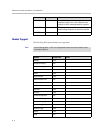
Session Initiation Protocol (SIP)
B - 9
Hold Implementation
The phone supports both currently accepted means of signaling hold.
The first method, no longer recommended due in part to the RTCP problems
associated with it, is to set the “c” destination addresses for the media streams
in the SDP to zero, for example, c=0.0.0.0.
The second, and preferred, method is to signal the media directions with the
“a” SDP media attributes sendonly, recvonly, inactive, or sendrecv. The hold
signaling method used by the phone is configurable (refer to SIP <SIP/>on
page A-10), but both methods are supported when signaled by the remote end
point.
Reliability of Provisional Responses
The phone fully supports RFC 3262 - Reliability of Provisional Responses.
Transfer
The phone supports transfer using the REFER method specified in
draft-ietf-sip-cc-transfer-05 and RFC 3515.
Third Party Call Control
The phone supports the delayed media negotiations (INVITE without SDP)
associated with third party call control applications.
When used with an appropriate server, the User Agent Computer Supported
Telecommunications Applications (uaCSTA) feature on the phone may be
utilized for remote control of the phone from computer applications such as
Microsoft Office Communicator.
The phone is compliant with “Using CSTA for SIP Phone User Agents
(uaCSTA), ECMA TR/087” for the Answer Call, Hold Call, and Retrieve Call
functions and “Services for Computer Supported Telecommunications
Applications Phase III”, ECMA – 269 for the Conference Call function.
This feature is enabled by configuration parameters described in SIP <SIP/>
on page A-10 and Registration <reg/> on page A-107 and needs to be
activated by a feature application key.
Note
Even if the phone is set to use c=0.0.0.0, it will not do so if it gets any sendrecv,
sendonly, or inactive from the server. These flags will cause it to revert to the other
hold method.


















